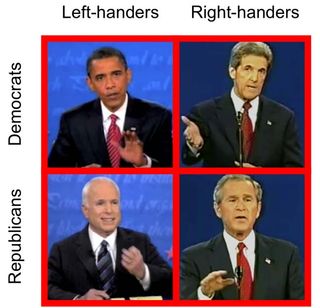Political Body Language: Left vs. Right

An analysis of body language in the last two sets of presidential debates reveals that the candidates — two right-handers in 2004, two lefties in 2008 — used their dominant hands for gestures while they were making a positive statement, and relied more frequently on their nondominant side when making a negative statement.
The findings of the Dutch study support the "body-specific hypothesis," which links the content of our minds to the structure of our bodies. They also confirm prior work in the laboratory showing that individuals link their dominant side with positive things – like intelligence, goodness – while associating their nondominant side with more negative attributes.
The last two U.S. presidential elections offered an unprecedented opportunity to test this theory with regard to speech and body language, said Daniel Casasanto of the Max Planck Institute for Psycholinguistics, in the Netherlands. In 2004, two righties, George W. Bush and John Kerry, squared off; then, four years later, two lefties, Barack Obama and John McCain, faced one another. [Read The History of Obama's Handedness.]
"It is as if history wanted us to do this study," said Casasanto, a cognitive scientist who is also an assistant professor at the New School for Social Research, in New York.
Coded body language
In previous studies, both children and adults given choices between two things — pictures of bunnies, drawings of aliens, job candidates' applications, descriptions of consumer products — showed preferences for the one presented to them on their dominant side, according to Casasanto.
For work published in July in the journal PLoS ONE, Casasanto had the videos and transcripts for the 2004 and 2008 debates coded for positive and negative speech. Obama's statement to the public, "You can keep your health insurance," for example, was coded as a positive statement. Separately, the footage was coded for left- and right-handed gestures. Then researchers looked for the relationship between the two.
Sign up for the Live Science daily newsletter now
Get the world’s most fascinating discoveries delivered straight to your inbox.
"It's easier to detect patterns in the nondominant hand, just because the gestures are fewer," Casasanto said. "The dominant hand makes so many gestures for positive and negative things."
While Obama used his right (nondominant) hand more than twice as often as his left to gesture during negative statements, McCain was 12 times as likely to do so. (McCain injured both arms, particularly his nondominant right arm, during his crash landing and captivity in the Vietnam War.) In 2004, Kerry's ratio was about 3-to-1, but Bush broke even, using his left (nondominant) hand while making 20 positive statements and 19 negative ones.
Despite the use of right and left metaphors to describe conservative and liberal politics, the study found party affiliation had no effect on the results. The implicit association between a positive or negative statement and the selection of a hand for gesturing "is something that Democrats and Republicans appear to agree on," according to Casasanto and his co-author at the Planck Institute, Kyle Jasmin..
Reverse preference
Although the ratio of lefties to righties is not known, it has been estimated that lefties make up about 10 percent of the world population, Casasanto says. The cultural consequences are clear around the globe: From phrases like "the right answer" and "two left feet" to the Islamic practice of reserving the right hand for eating and the left hand for dirty jobs, lefties have been put at odds with cultural norms around the world.
Even so, lefties have been "massively overrepresented" in the White House, according to Casasanto. (Starting with Gerald Ford, five of the seven most recent presidents have been left-handed.) Casasanto, who was born in the United States, has a theory: "We, the right-handed majority of the voters, see them gesturing more often with their dominant hand, that means they are waving on our good side of the television screen."
Work he has done since analyzing the debate footage indicates that handedness, and the associations that come with it, can change.
"In 12 frustrating minutes you can turn a genetic right-hander into a functional left-hander by making them do a fine motor task with a bulky ski glove on the right hand," Casasanto said, describing more recent research. After being forced to switch dominant sides, the right-handed subjects — turned into temporary lefties — linked the left side with all things positive.
- Quiz: Bizarre U.S. Presidential Elections
- What Makes a Lefty: Myths and Mysteries Persist
- Top 10 Ailing Presidents

